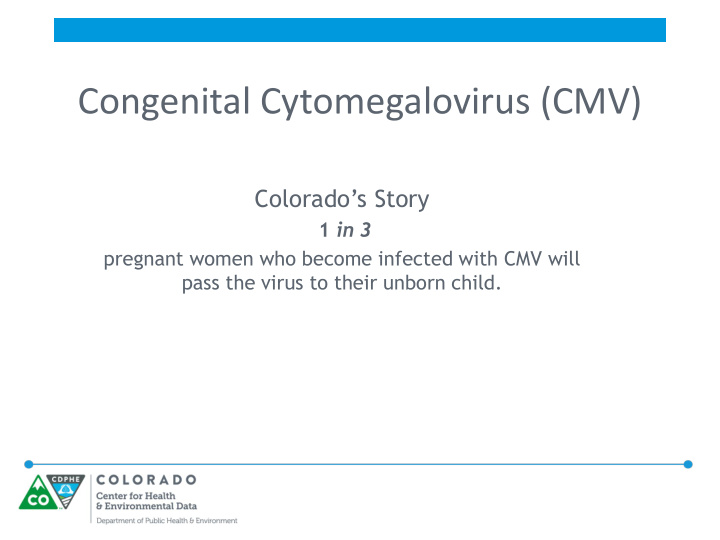



Congenital Cytomegalovirus (CMV) Colorado’s Story 1 in 3 pregnant women who become infected with CMV will pass the virus to their unborn child.
Cytomegalovirus (CMV) CMV: cytomegalovirus is a very common virus. The majority of adults carry the virus by the time they are 40 years of age and carry the virus for life (usually in a dormant or inactive state). CMV can cause significant problems in a newborn if the mother gets the infection during pregnancy. About 10% of babies who are infected with the CMV virus before birth (congenital CMV infection) will have some abnormalities.
What Symptoms Should I Look For? Usually, CMV does not cause symptoms or only causes mild symptoms. Symptoms of CMV can include: • Sore throat • Swollen lymph nodes (lymph glands) • Fever • Headache • Fatigue • Weakness • Muscle aches • Loss of appetite
How Does the Virus Spread? CMV is spread from one person to another, usually by direct and prolonged contact with bodily fluids, including: • Saliva • Urine • Breast milk • Semen **This only happens when the person with the virus has an active infection (not dormant).
Prevention HOW DO I PREVENT BECOMING INFECTED? Make sure you wash your hands after: • Changing diapers • Feeding a child • Wiping a child’s nose or mouth • Handling a child’s toy
Colorado Cases • CMV IS A REPORTABLE CONDITION TO CRCSN Reported cases of CMV by year Congenital CMV 2014 2015 Total ICD-9: 771.1 8 6 14 ICD-10: p35.1 n/a 5 5 Birth Population 65,815 66,566 Total 8 11 19 **2016 cases: 12 incomplete
CMV Intervention OPPORTUNITIES FROM SCREENING • The gold standard for the diagnosis of congenital CMV infection is positive results for viral isolation from urine and/or saliva collected during the first 3 weeks of life. ** Not suitable for large scale screening • As an alternative, dried blood spots (DBS) polymerase chain reaction (PCR) assays are getting more and more attention, because specimens can be collected routinely and preserved easily; and because PCR can be automated. **Requires larger volume of blood than normal dried blood spot-used for retrospective research such as hearing loss
In Memory of Jayden 2008-2011 303-692-2636 http://www.cdc.gov/cmv/congenital-infection.html Margaret.ruttenber@state.co.us Margaret F . Ruttenber, MSPH http://www.cdc.gov/cmv/congenital-infection.html https://www.colorado.gov/cdphe/monitoring-and-preventing-birth-defects
Recommend
More recommend